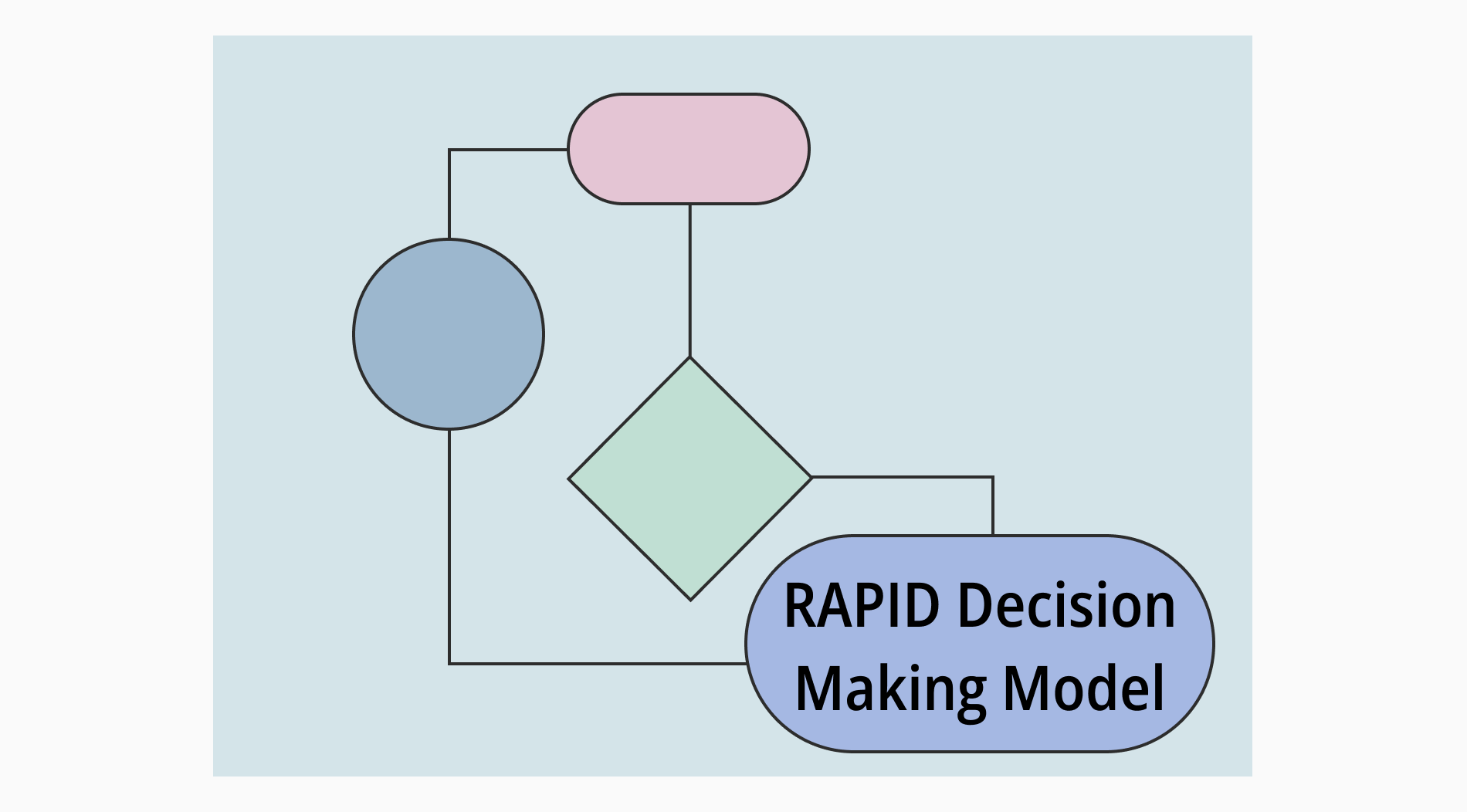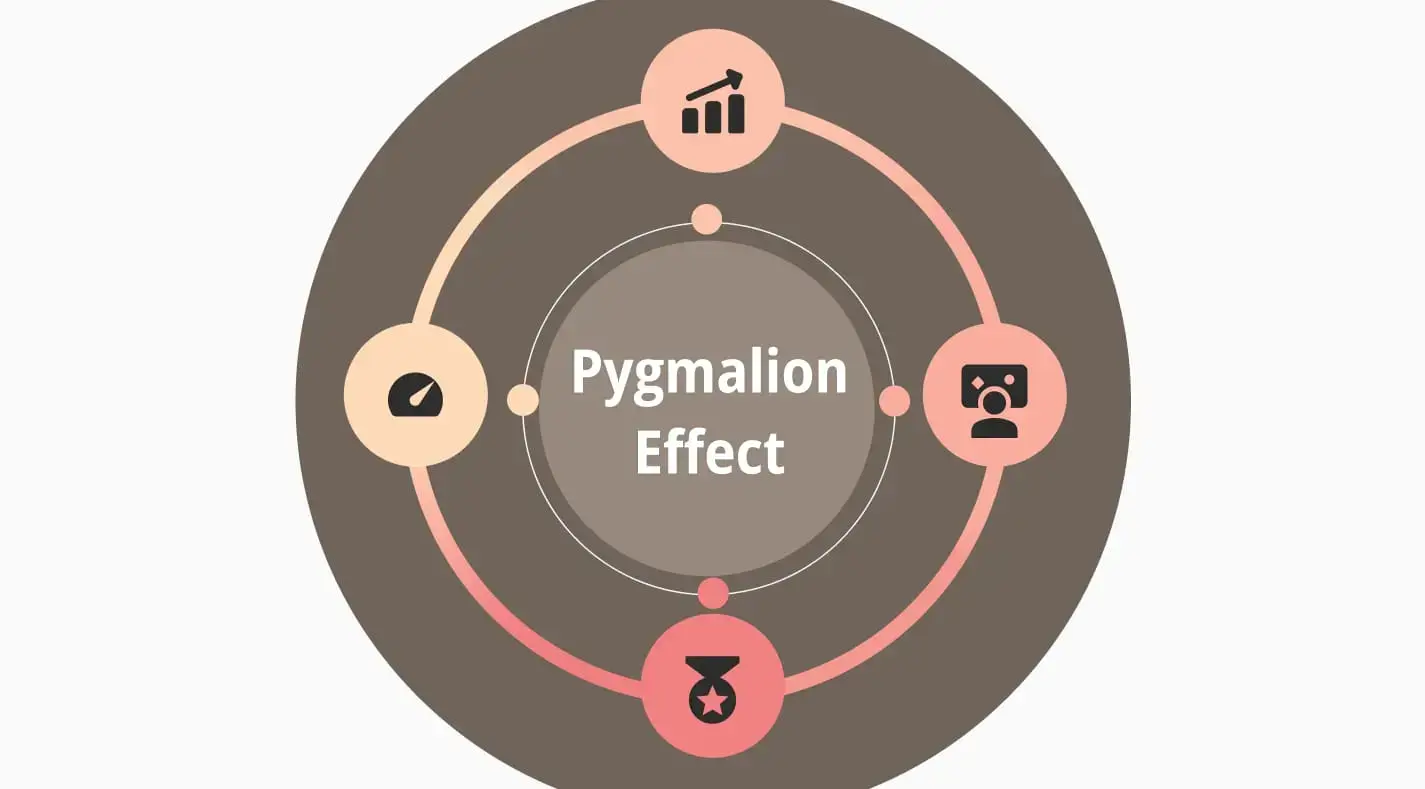
In today's competitive business landscape, understanding psychological factors is crucial for success. These factors, such as the Pygmalion Effect, directly influence employee performance, motivation, and overall productivity. By leveraging psychological insights, businesses can create more effective management strategies, foster a positive work culture, and ultimately drive growth and innovation.
Today, we'll explore the Pygmalion Effect, a key psychological model. We'll delve into its origins, the complete cycle, effective business applications, real-world examples, and its advantages, and address frequently asked questions. Understanding this model can transform management strategies, enhance employee performance, and drive business success.
The Pygmalion Effect: Definition

The Pygmalion Effect is a psychological phenomenon where higher expectations lead to improved performance.
Originating from a study by Rosenthal and Jacobson, it demonstrates that people tend to meet the expectations set for them. This effect highlights the power of positive expectations in shaping behavior and outcomes.
In practice, the Pygmalion Effect shows that when managers believe in their employees' potential, it boosts their confidence and productivity. These positive expectations create a feedback loop where employees strive to meet and exceed expectations, leading to better performance and job satisfaction.
Where does the phrase come from?
The Pygmalion Effect originates from a Greek myth. Pygmalion, a sculptor, created a statue so beautiful that he fell in love with it. His unwavering belief and desire for the statue to come to life were fulfilled by the goddess Aphrodite. The myth of Pygmalion illustrates the power of belief and expectation in bringing about desired outcomes.
Psychologically, the Pygmalion Effect was first identified by researchers Robert Rosenthal and Lenore Jacobson in the 1960s. Their study in a school control group setting found that students who were expected to excel academically by their teachers’ expectations showed significant improvements in performance. This groundbreaking Rosenthal effect concluded that the Pygmalion is an influence of expectations on human behavior and performance.
In the context of business, the Pygmalion Effect underscores the importance of leadership expectations. When managers have high expectations of their employees, it can lead to enhanced performance and job satisfaction. This principle demonstrates that belief in potential can drive real, measurable success, transforming organizational culture and productivity.
The Pygmalion Effect Cycle
The Pygmalion Effect circle is a self-fulfilling prophecy cycle where positive expectations lead to improved performance. It begins with a leader or manager's high expectations for an employee. This belief influences the manager's behavior, leading them to provide more support, encouragement, and opportunities for the employee.
The employee, sensing these high expectations and support, gains confidence and motivation. This boost in self-esteem and effort results in better performance. As the employee performs better, the manager's positive expectations are reinforced, leading to continued high expectations and further support.
This cycle of expectation, behavior, performance, and reinforcement creates a continuous loop. The Pygmalion Effect circle demonstrates how positive beliefs and expectations can perpetuate a cycle of improvement and success, significantly enhancing workplace productivity and morale.
Steps of the Pygmalion Effect Cycle
Let's explore the steps of the Pygmalion Effect cycle, which includes expectation formation, behavior adjustment, employee response, performance improvement, and reinforcement of expectations. Understanding these steps will help you leverage this powerful psychological phenomenon to boost performance, enhance motivation, and drive success within your organization.
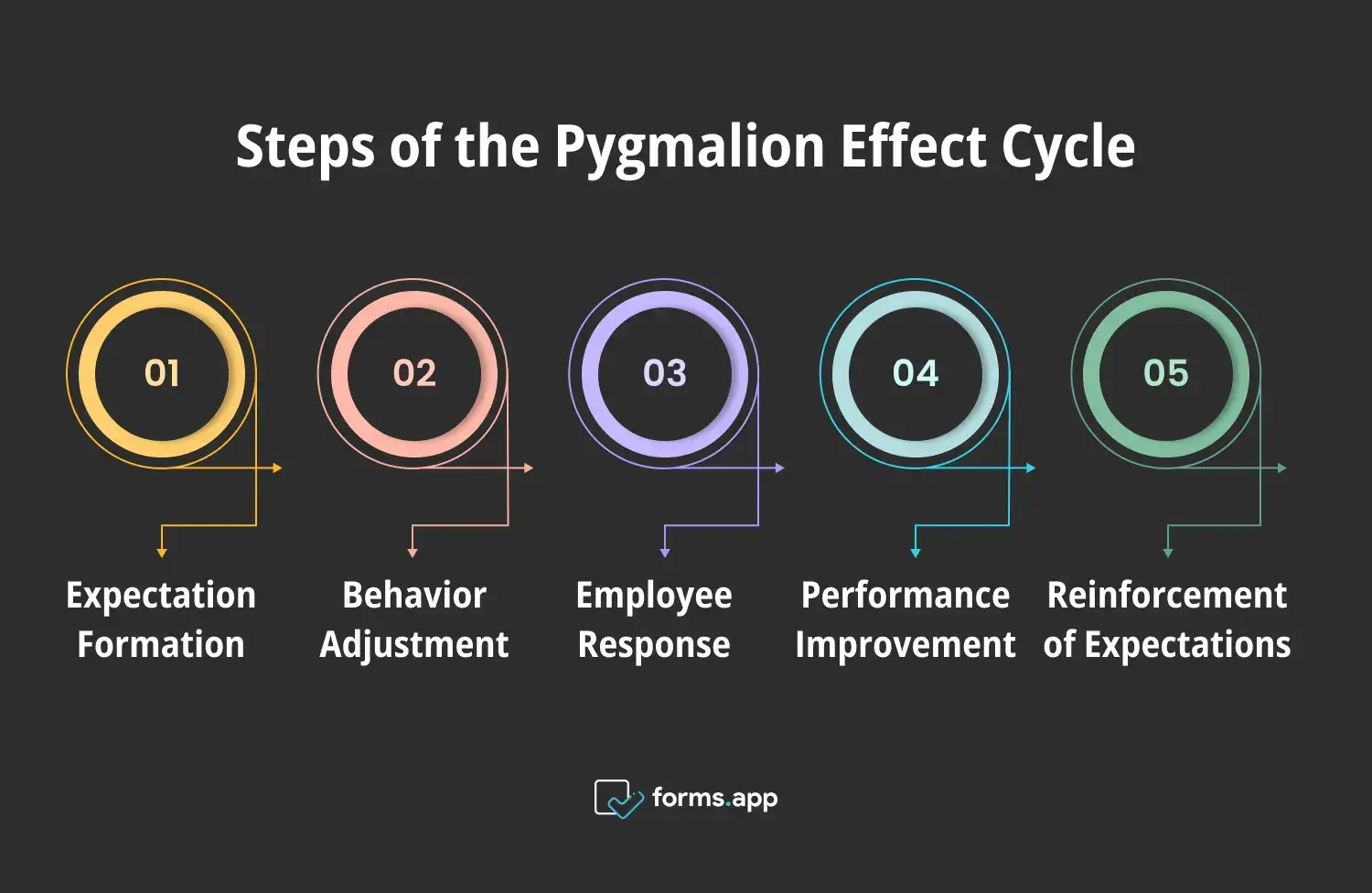
Pygmalion Effect Cyyle Steps
1- Expectation Formation
Managers form high expectations for an employee's potential and capabilities. This step is crucial as it sets the tone for subsequent interactions. Positive or negative expectations are often based on initial assessments, past performance, or inherent biases, consciously or unconsciously shaping how the manager perceives and interacts with the employee.
2- Behavior Adjustment
Managers adjust their behavior to align with their high expectations. This includes providing more feedback, offering additional support, and assigning challenging tasks. These behaviors signal to the employees that they are valued and capable, fostering a supportive environment that encourages growth and development.
3- Employee Response
Employees perceive their manager's high expectations and supportive behavior. This perception boosts their self-esteem and motivation, leading them to invest more effort and take initiative. The belief that their manager has confidence in their abilities inspires employees to strive for higher performance and overcome challenges.
4- Performance Improvement
As employees respond to positive expectations and increased support, their performance improves. This improvement can manifest in various forms, such as higher productivity, better quality of work, or more innovative solutions. The tangible progress reinforces the employee's confidence and commitment to maintaining high performance.
5- Reinforcement of Expectations
Managers observe the improved performance and their positive expectations are reinforced. This reinforcement strengthens the manager's belief in the employee's potential, perpetuating the cycle. The continued high expectations and support create a feedback loop, further encouraging the employee to excel and sustain their enhanced performance.
Usage of the Pygmalion effect in the business world
Let's examine the usage of the Pygmalion Effect in business. This includes setting clear, high expectations; providing adequate training and resources; offering regular feedback and support; recognizing and celebrating achievements; fostering a positive work environment; and monitoring and adjusting expectations. Implementing these strategies can significantly enhance employee performance and drive organizational success.
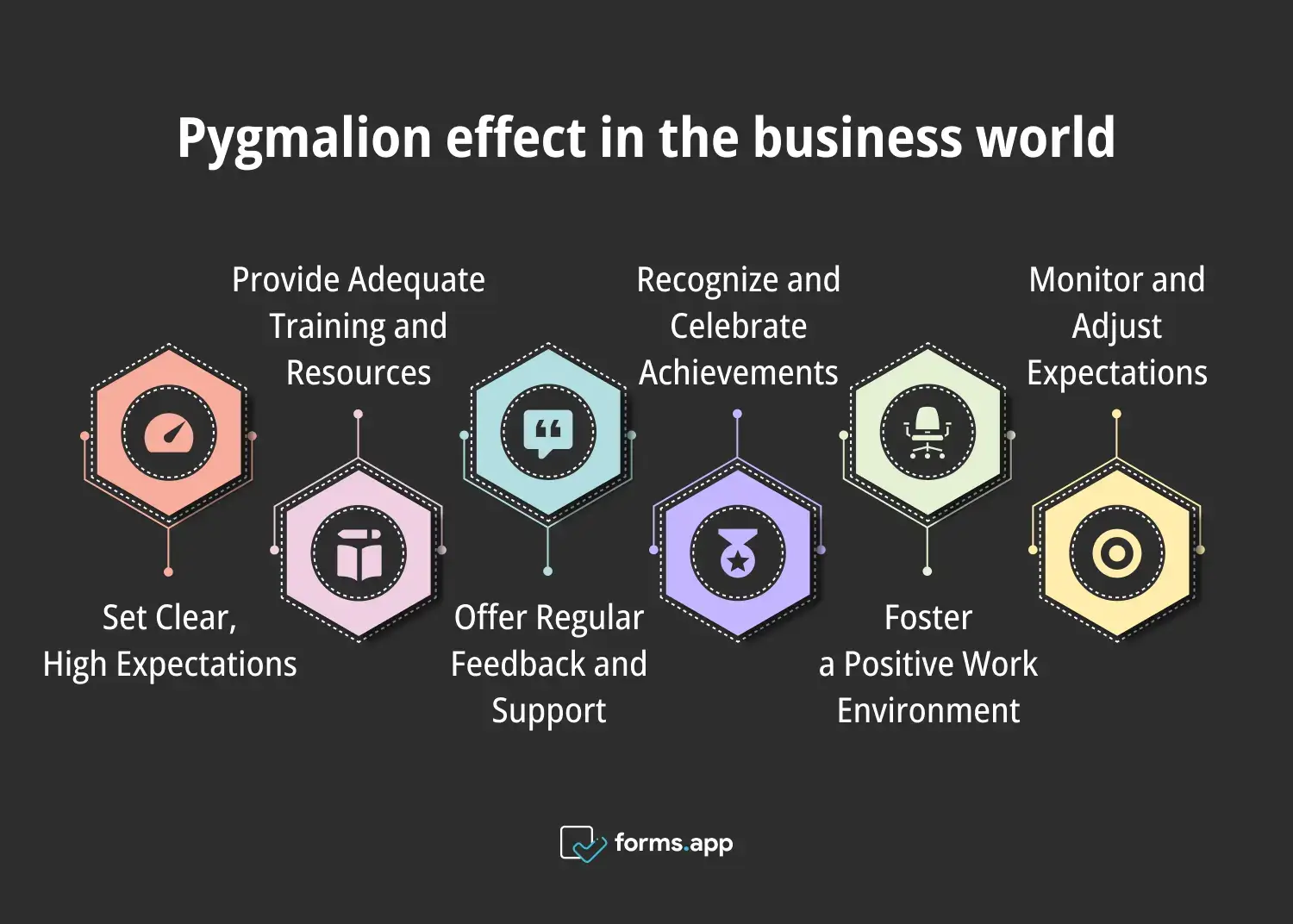
How to use the Pygmalion Effect in your business
1- Set Clear, High Expectations
Establish clear, ambitious, yet achievable expectations for employees. Communicate these expectations effectively, ensuring that employees understand the goals and believe they are attainable. High expectations should be specific and aligned with the company’s objectives, providing a roadmap for employees to follow and strive towards in their daily tasks.
2- Provide Adequate Training and Resources
Equip employees with the necessary training and resources to meet high expectations. This includes offering skill development programs, access to tools, and ongoing support. Ensuring employees have what they need to succeed reinforces the belief that they can achieve the set goals, fostering a more competent and confident workforce.
3- Offer Regular Feedback and Support
Implement a system of regular feedback and support. Constructive feedback helps employees understand their progress and areas for improvement, while positive reinforcement encourages continued effort. Supportive interactions build trust and demonstrate that managers are invested in employees’ success, further motivating them to perform at their best.
4- Recognize and Celebrate Achievements
Acknowledge and celebrate employees’ achievements and milestones. Recognition, whether through formal rewards or simple verbal praise, reinforces positive behavior and performance. Celebrating success boosts morale and shows employees that their hard work is valued, encouraging them to maintain or exceed their performance levels.
5- Foster a Positive Work Environment
Cultivate a positive and supportive work environment where employees feel valued and respected. Encourage collaboration, open communication, and a culture of continuous improvement. A positive workplace atmosphere enhances employee satisfaction and engagement, making them more likely to respond positively to high expectations and contribute effectively to the organization’s goals.
6- Monitor and Adjust Expectations
Regularly review and adjust expectations to ensure they remain challenging yet realistic. Continuous monitoring helps identify any barriers employees may face and allows managers to provide additional support where needed. Adjusting expectations based on performance and feedback ensures that goals remain relevant and attainable, sustaining motivation and growth.
Example of the Pygmalion effect
Let’s see a Pygmalion effect example. We will look at a scenario. In it, we will witness Google using the Pygmalion Effect at its business level and getting positive results. It will help us gain a better understanding of the model.
At Google, the Pygmalion Effect is in the organizational culture, driving innovation and excellence. Imagine a scenario where a team of engineers is tasked with developing a new feature for an upcoming product launch. The team lead, inspired by Google's culture of high expectations and empowerment, sets ambitious yet achievable goals for the project.
The team members, fueled by their manager's confidence and support, approach the project with enthusiasm and determination. They collaborate closely, leveraging their diverse skills and expertise to overcome challenges and deliver exceptional results. The positive atmosphere fosters creativity and collaboration, leading to the development of a groundbreaking feature that exceeds expectations.
As the project nears completion, the team receives recognition and praise for their outstanding work. Google's culture of celebrating achievements reinforces the team's belief in their capabilities and motivates them to continue pushing boundaries. The successful outcome not only enhances the product but also boosts morale and fosters a sense of pride and accomplishment among team members.
Why to use the Pygmalion effect in the workplace
Key reasons include enhanced performance, increased motivation, improved employee engagement, a positive work culture, better communication, faster skill development, increased innovation, and stronger team dynamics. Leveraging this effect can transform your organization's productivity and employee satisfaction. Let's delve into why you should use the Pygmalion Effect in the workplace:
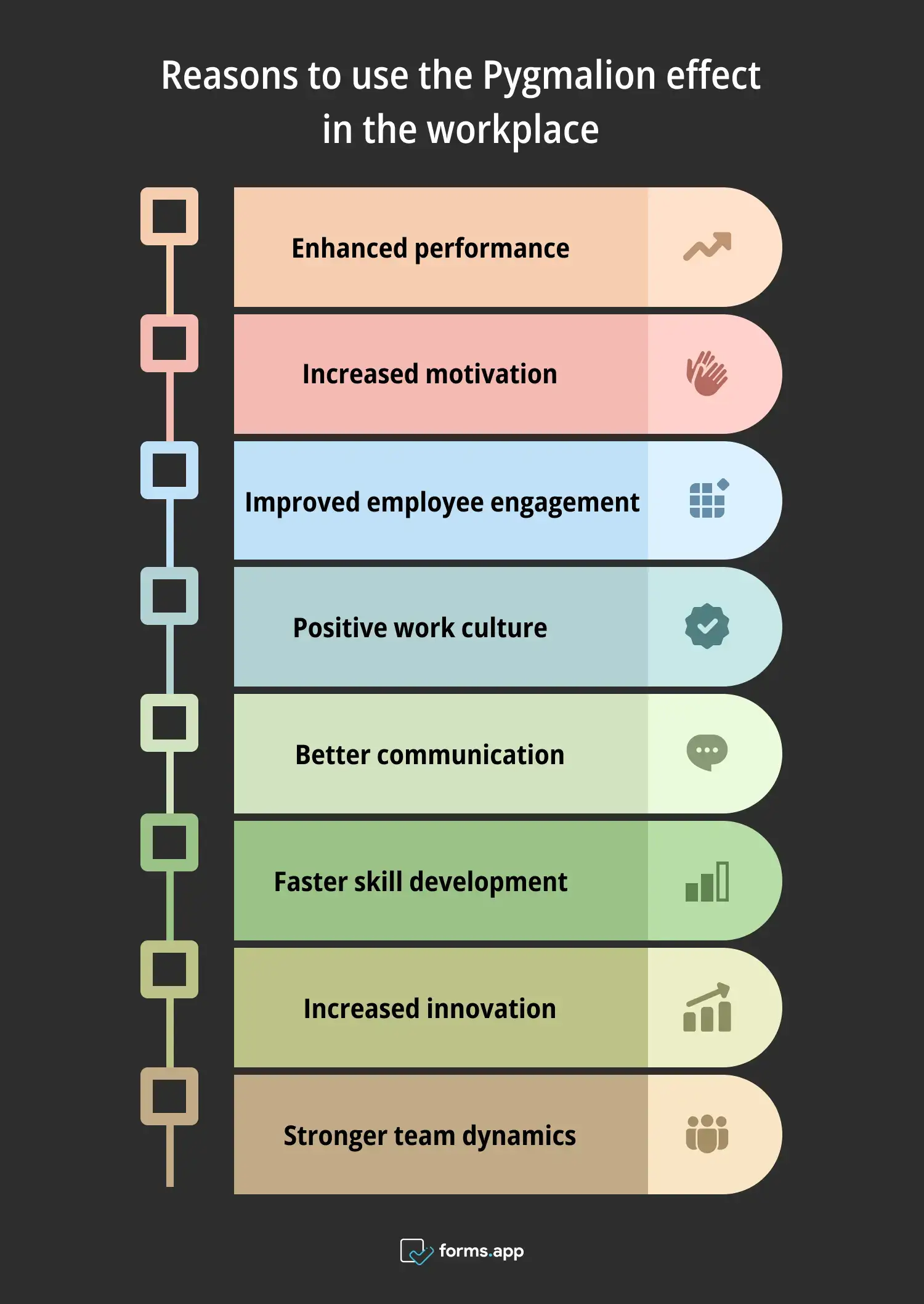
Pros of using the Pygmalion effect in your business
💡Enhanced performance: Leveraging the Pygmalion Effect boosts employee performance as they strive to meet and exceed high expectations set by managers, resulting in improved productivity and quality of work.
💡Increased motivation: Positive expectations foster a sense of confidence and motivation among employees, inspiring them to take ownership of their work and pursue excellence.
💡Improved employee engagement: Employees who feel valued and supported are more engaged in their work, leading to higher levels of job satisfaction and retention.
💡Positive work culture: Creating a culture of high expectations and support fosters a positive work environment where employees feel empowered and motivated to succeed.
💡Better communication: Managers who believe in their employees' potential are more likely to communicate effectively, provide constructive feedback, and offer guidance, leading to stronger relationships and clearer expectations.
💡Faster skill development: High expectations encourage employees to stretch their abilities and seek out opportunities for growth and development, accelerating their skill acquisition and career progression.
💡Increased innovation: Employees who feel confident and supported are more likely to think creatively, take risks, and contribute innovative ideas to the organization.
💡Stronger team dynamics: The Pygmalion Effect promotes collaboration and teamwork as employees work together to meet shared goals and objectives, leading to stronger team cohesion and performance.
Frequently asked questions about the Pygmalion effect
Let's address some frequently asked questions about the Pygmalion Effect. We'll explore the Pygmalion strategy, its impact on sales, its role in leadership, its meaning in business, and its effect on marketing. Understanding these aspects will provide a comprehensive view of how the Pygmalion Effect can be applied effectively in various business contexts.
A estratégia Pygmalion envolve a definição de expectativas elevadas para indivíduos ou equipas, acreditando no seu potencial e fornecendo apoio para os ajudar a atingir essas expectativas. Esta estratégia aproveita o Efeito Pigmalião, em que as crenças positivas conduzem a um melhor desempenho, impulsionando o sucesso em várias áreas de negócio.
Nas vendas, o efeito Pigmalião pode ter um impacto significativo no desempenho. Quando os gestores de vendas têm grandes expectativas em relação aos membros da sua equipa, isso pode levar a uma maior motivação, confiança e, em última análise, a resultados de vendas mais elevados. As crenças positivas nas capacidades dos vendedores podem inspirá-los a exceder os objectivos e a alcançar um maior sucesso nas suas funções.
O Pigmalião na liderança refere-se ao fenómeno em que as expectativas dos líderes influenciam o desempenho dos seus seguidores. Quando os líderes têm grandes expectativas em relação aos membros da sua equipa, isso pode inspirar um maior esforço, empenho e realização. Esta abordagem de liderança enfatiza a crença no potencial dos funcionários e fornece apoio para os ajudar a atingir os seus objectivos.
No mundo dos negócios, o Efeito Pigmalião refere-se ao fenómeno em que expectativas mais elevadas conduzem a um melhor desempenho. Quando os gestores acreditam nas capacidades dos seus empregados e estabelecem expectativas elevadas, isso pode influenciar positivamente a motivação dos empregados, a produtividade e o sucesso global da organização.
No marketing, o Efeito Pigmalião pode influenciar o comportamento do consumidor e a perceção da marca. Quando os profissionais de marketing criam campanhas que evocam expectativas elevadas e associações positivas com os seus produtos ou serviços, isso pode levar a um aumento do interesse, da lealdade e da intenção de compra dos consumidores. As crenças positivas sobre uma marca podem impulsionar o envolvimento do consumidor e contribuir para o seu sucesso no mercado.
Key points to take away
In summary, the Pygmalion Effect highlights the power of positive expectations in driving performance and success. By understanding its origins, implementing its cycle in business, and recognizing its benefits, organizations can enhance motivation, productivity, and innovation. Using the Pygmalion Effect through effective leadership and supportive environments can transform workplace dynamics and achieve remarkable outcomes.
In this guide, we covered the origins of the Pygmalion Effect, its cyclical steps, advantages in the workplace, and practical examples, such as Google's success. Additionally, we answered frequently asked questions to provide a comprehensive understanding of how to apply this powerful psychological model in various business contexts.
Fatih is a content writer at forms.app and a translator specializing in many text domains, including medical, legal, and technical. He loves studying foreign languages. Fatih especially likes to create content about program management, organizational models, and planning tools.
Índice de Conteúdos
- The Pygmalion Effect: Definition
- Where does the phrase come from?
- The Pygmalion Effect Cycle
- Steps of the Pygmalion Effect Cycle
- Usage of the Pygmalion effect in the business world
- Example of the Pygmalion effect
- Why to use the Pygmalion effect in the workplace
- Frequently asked questions about the Pygmalion effect
- Key points to take away



 8 min ler
8 min ler
